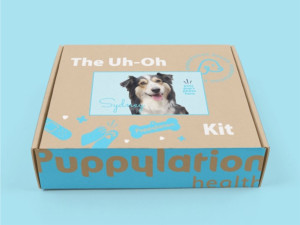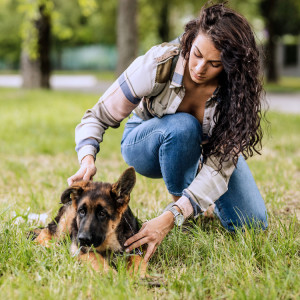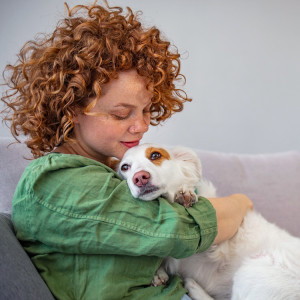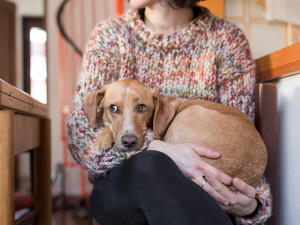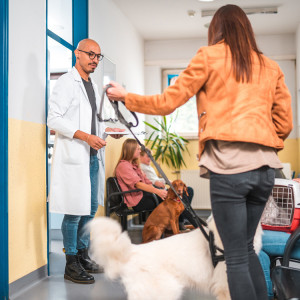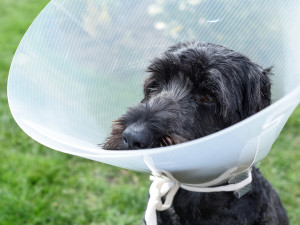How to Care for Your Bleeding Dog
Don’t freak out—here’s what to do.
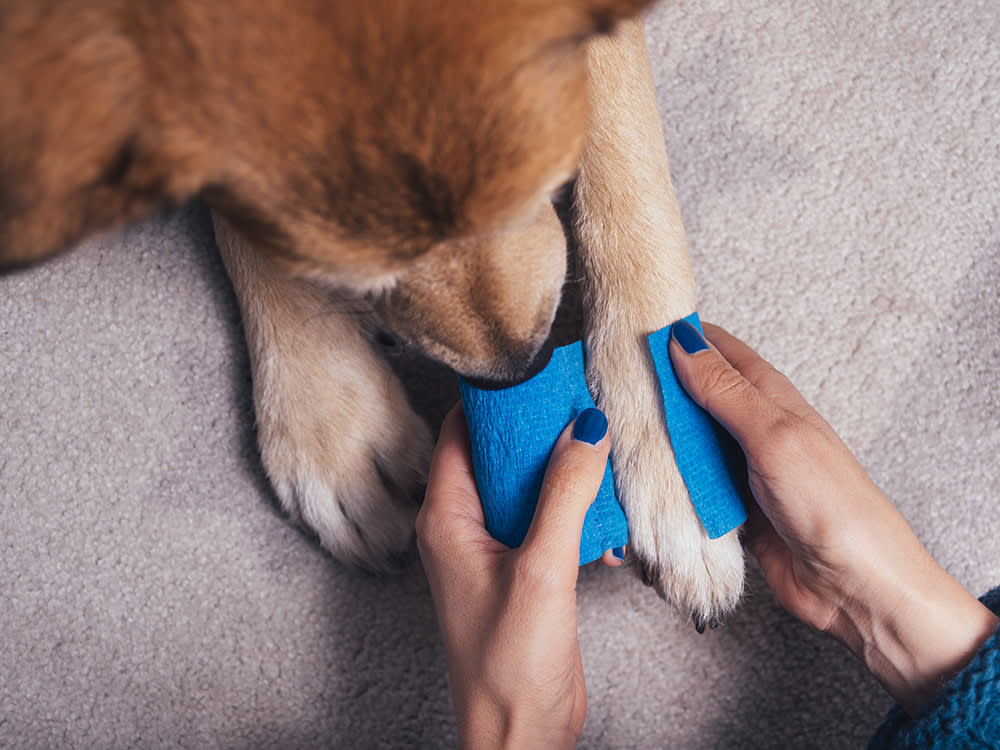
Share Article
In This Article:
Before Starting First Aid Signs of External Bleeding Care for External Bleeding Internal Bleeding When Should I Take My Dog to The Vet? How to Prevent Future Bleeding Incidents
You should promptly take care of bleeding cuts on your pet to prevent infection or other complications. Follow these first aid guidelines to control bleeding and properly care for minor lacerations at home.
Step One: Stop the Bleeding.
First, apply gentle pressure to the wound with a clean, absorbent cloth or piece of gauze for five to 10 minutes to encourage clotting and stop bleeding. Keep your pet calm by stroking their fur as you apply steady pressure.
Step Two: Clean the Cut.
Once the bleeding stops, flush the wound gently under cool running water to remove debris and dirt. Trim the hair around the cut if needed for better visibility. Avoid using alcohol, peroxide, or soap directly in wounds.
Step Three: Prevent Infection.
Apply an antibacterial ointment safe for pets gently across the injury using a sterile piece of gauze to prevent infection.

Step Four: Protect Your Pet.
Cover the cut with sterile, non-stick bandages or pads to keep it clean while it heals. For areas that are difficult to bandage, like your pet’s paws or abdomen, opt to leave it uncovered and check and clean twice daily instead.
Step Five: Check the Wound Frequently.
Monitor your pet closely over the next few days. Check the injury site daily for increased redness, swelling, or discharge, which may indicate infection — consult with your pet’s vet immediately if you notice these signs! Sutures may be needed if wound edges separate excessively during the healing period.
The following techniques are listed in order of preference. As a word of caution: The first rule when dealing with an injured pet is to avoid injury to yourself. Take appropriate precautions, such as the use of a muzzle, to avoid being bitten.
The best way to learn these techniques is in a pet first aid class. You can sign up for classes, which are offered by local chapters of the American Red Cross, some shelters and humane organizations. Also, it’s a good reminder to have a complete pet first aid kit (which includes a muzzle) among your dog supplies.
How to care for your bleeding dog
Bleeding can occur for many reasons, and sometimes there is an obvious cause, such as a hit-by-car accident, while other times it seems to come out of nowhere. In many cases, the blood that you can see is part of a larger problem, including other less obvious injuries in addition to the wound, or an underlying illness, such as a bleeding disorder or cancer. It is not enough to simply stop the bleeding.
Your dog will need a thorough evaluation by a vet along with tests like bloodwork and X-rays to determine the extent of their injuries or illness. In many cases, the bleeding you can see is just the tip of the iceberg, and the more serious problems are not obvious, so getting to a vet right away and treating the most life-threatening parts of their problem are crucial. Don’t spend a lot of time at home trying to stop the bleeding; your best bet is to head to the vet and do as much as you can on the way with the help of a first aid kit. Below are some tips to keep in mind as you do your best to help your pup en route to the vet.
Before starting first aid
You will want to take a few important safety steps prior to initiating any first aid measures. First, get to a safe, quiet location with your dog as quickly as possible. If your dog was attacked by another dog or hit by a car, for example, make sure to move to a safe location where both you and your dog are out of harm’s way before trying to start any first aid. It can be difficult to remember this in the moments after an accident when adrenaline is pumping, but you don’t want to compound their injuries by having you or your dog get injured any more. Make sure your dog has their collar and leash on so that they don’t stumble into a dangerous situation, especially if they are in pain, anxious, or scared.
If you need to get any information from other people regarding the accident, such as vaccine records for another dog involved in an attack or a driver’s information, try to quickly get the basics before leaving the scene. In other cases, things won’t be quite so dramatic if your dog’s injury happened at home, or seems to be related more to an underlying medical condition or bleeding disorder.
Even in these situations, remembering to do basic safety steps like securing your dog’s leash and collar, writing down important information, and contacting whomever you need to help get your dog to the vet are very important when you may not be thinking clearly in a crisis.
How to avoid personal injury while helping your dog
Along these same lines, keep your own personal safety in mind as you try to help your dog. An injured dog may be in a lot of pain in places you can’t obviously see, and they may be scared or disoriented, too. These situations can make even the most docile dogs more likely to bite out of fear and/or to protect themselves from pain. If you can’t safely handle your injured dog, you may need to get a large thick blanket or crate to safely transport them to the vet. This can also be helpful if they are too injured to walk; you may need to carry them to a safe location, into and out of the car, and to the vet clinic.
Using a muzzle can help to keep you and other handlers safe, especially if your dog tends to bite at the vet in general. Even if you have never needed to use a muzzle for your dog, consider keeping one in your first aid kit just for these kinds of emergencies. And in a pinch, you can create a makeshift muzzle out of a long piece of soft fabric, such as a men’s tie, a leash, or cloth. You’ll want to be sure your dog can still breathe and pant with the muzzle in place so make sure it is not too tight, and only put it on when necessary. If you can’t safely muzzle your dog, use one of the other techniques to confine them, like a crate, and get them safely to the vet for evaluation. Don’t waste time trying to find fabric to make a muzzle if your dog is actively bleeding and trying to bite. Your vet will have all the necessary tools to help your dog so getting to the vet is the main priority.
How to identify the source of the bleeding
If you are seeing blood around the house or on your dog’s bed, but you can’t figure out where it is coming from, you may need to do some investigating to find the source of the bleeding. Once again, in an emergency situation in which your dog may have life-threatening injuries, such as after a hit-by-car scenario, you don’t want to spend precious time searching for the source of bleeding if that means taking longer to get to the vet.
If your dog seems stable and is acting normal at home but seems to be bleeding from somewhere, you have the luxury of a little more time to try and figure things out. In that case, you’ll want to take a head-to-toe approach to examine your dog and look for any sources of bleeding. Common sources of bleeding can be injuries to the paws or toenails, injuries to the tail, blood in the urine, blood from a broken tooth or tongue injury, or bleeding around the genitals or anus.
Of course, bleeding can happen anywhere on the body, so you’ll want to take a meticulous approach and check everything. If your dog does not seem stable (they are unable to stand up, they are breathing heavily, they are disoriented, or they collapse), head straight to the vet and skip this evaluation.
Signs of external bleeding
The most obvious sign of external bleeding is the discovery of blood. You might find drops of blood on the floor, on your dog’s bed, or matted fur that has dried blood caked in it. Dogs who have lost a lot of blood will also show signs of anemia and/or shock. This includes weakness, rapid breathing, fast heart rate, pale gums, and/or collapse.
These signs mean that your dog has lost a lot of blood and needs emergency care right away. A dog who is running around, has bubble-gum pink gums, is wagging their tail, eating and acting normally is not in immediate danger from anemia, and you can take a little more time to try to determine what’s going on.
External bleeding means bleeding that is visible outside of the dog. This can happen for many reasons including trauma, infections, tumors, and/or bleeding disorders, such as congenital abnormalities and certain toxins, like rodenticide. So while a smaller amount of bleeding is not necessarily life-threatening, it is always a good idea to have your vet check it out to look for any of these underlying problems, which can become more serious. Here are some common causes of external bleeding:
Paw
Cuts on paw pads, broken toe nails, paw pad burns
Gums
Broken teeth, injuries from chewing on sticks or other sharp objects, periodontal disease and tooth decay, bleeding gums secondary to a bleeding disorder (no trauma)
Butt
Blood in the stool can sometimes be seen around the butt, making pet parents wonder if their dog’s butt is actually bleeding. They can also have bleeding around their butt if they have an anal gland problem, such as an abscess that ruptures in that area.
Torso
This is a common place for bite wounds as well as trauma after a dog is hit by a car and other accidents. Injuries to the torso must always be taken seriously even if they appear small because these injuries can sometimes penetrate into the body, injuring internal organs as well.
Legs
The limbs can often be injured in trauma. Any bleeding wounds on the limbs can also be associated with underlying broken bones, so use caution in handling these kinds of injuries as they may be extremely painful. This is especially important to keep in mind if your dog is limping or unable to walk and has a bleeding wound on the limb.
Penis
Pet parents may notice bleeding from the penis when there is blood in the urine. This can happen if a dog has bladder stones, a urinary tract infection, or even certain kinds of cancer. This can also happen when there is a bleeding disorder. Other causes of bleeding from the penis can be related to trauma or prostate gland problems.
Vagina
Pup parents may notice bleeding from their dog’s vagina for a number of reasons. The most common would be for dogs who are not spayed and go into heat. Other times, dogs who are not spayed can also develop an infection of the uterus, called a pyometra, which can cause bloody discharge with pus.
Female dogs might also have some bleeding from the vagina if they are giving birth or just recently gave birth. Finally, when there is blood in the urine, it can seem like the vagina is bleeding and this can happen if a dog has bladder stones, an infection, or even certain kinds of cancer.
How to care for external bleeding
If you have identified that your dog is actively bleeding from a specific site, you can take steps to try to stop the bleeding on your way to the vet hospital. The main goal is to try to avoid shock from blood loss. This happens when there is not enough blood circulating throughout the dog’s body. Without an adequate blood volume, critical organs, such as the brain, kidneys, and GI tract are not getting oxygen and nutrients, which can lead to organ failure and can quickly turn fatal.
Your veterinarian can tell if your dog is in shock through physical exam findings such as a high heart rate, a low blood pressure, and weak pulses. The best way to learn first aid techniques is in a pet first aid classopens in new tab. You can sign up for classes, which are offered by local chapters of the American Red Cross, some shelters and humane organizations. Here are a few ways to control bleeding in your pet during transport to your nearest veterinary hospital.
1. Gather supplies
This is an important first step and ideally, should be done prior to an emergency by keeping a well-stocked first aid kit on hand. That way, in a moment of crisis, you are not running around looking for your supplies. Some basic supplies to collect include non-stick bandage pads like Telfa pads, gauze squares, clean towels and a muzzle. Some basic ways to reduce blood loss include:
2. Applying direct pressure
This is the best option whenever possible. The goal is to compress the blood vessels enough to slow blood loss while allowing time for a blood clot to form. Ideally, apply a non-stick bandage, like a Telfa pad, directly over the wound and then use layers of gauze or clean towels to bulk up the compress. This prevents bandage material from sticking directly to the open wound. You’ll want to keep the compress in place with firm pressure as long as possible.
If blood is soaking through the layers of the compress, it’s best to add another layer rather than pull off the existing layers so as not to disrupt any blood clots. In some cases, applying pressure is not possible. This may happen if the wound is in a hard-to-reach area, like inside the mouth. More often, a dog may be in too much pain to cooperate if you try to touch a fresh wound and they may not sit still for you to put pressure on the area. In that case, continue on to the vet as soon as possible. Your dog will likely need pain medications to relieve some of their discomfort for further handling to be safe and effective.
3. Elevating the wound
This strategy is more difficult to accomplish in dogs compared to humans but can be used for wounds on the lower limbs or possibly on the tail. The general idea is that if you elevate an injury that is far away from the heart, you can lower the blood pressure to that extremity and minimize how much blood reaches the area. Then less blood is lost. This relies on being able to elevate the wound effectively, which means it really only works on larger dogs and only when the wound is on a lower limb or tip of the tail.
You also need a dog willing to cooperate, which may be especially challenging if they have other injuries like broken bones that make it difficult to hold their injured limb or tail in an elevated position. Ideally, you should also apply direct pressure while elevating the injury. In most cases, this is not going to make a dramatic difference so it is only worth doing with a cooperative dog on your way to the vet hospital.
4. Tie a tourniquet
You’ve likely seen this in a movie or TV show when someone saves the day by tightly wrapping a belt or tie around a severe bleeding wound. What they don’t explain is that a proper tourniquet cuts off nearly all blood supply to everything below it, causing irreversible damage to those tissues. That said, this should only be used as an extremely desperate measure in a dog that might otherwise bleed to death before reaching a hospital. This means that they are losing so much blood so quickly that applying pressure isn’t working. This would be most likely to happen when an artery is bleeding, which results in much more forceful spurting, blood loss, and a dog who is very weak, pale, and possibly has collapsed.
When you place a tourniquet, you want to tie it so tightly so as to intentionally cut off circulation below that point. Some sources recommend tying a piece of fabric in a knot tightly above the wound and then tying a firm object like a stick, pen, or screw driver into the knot. You can then twist the rigid object to tighten the bandage and minimize blood loss. A tourniquet should not be left in place for more than 15 to 20 minutes because anything longer may result in permanent damage to the tissues. In most cases, if a tourniquet is used effectively, the lower portion of the limb or tail will ultimately have to be amputated due to the tissue damage, so be sure to avoid this whenever possible.
Signs of internal bleeding
Internal bleeding means that your dog is bleeding inside a body cavity, so no blood is visible on the outside. This can happen in the abdomen or chest and can occur after trauma, as well as with conditions like certain toxins, bleeding disorders, or cancers. Sometimes, there are no obvious external signs if the bleed is small; however, if there is a lot of blood loss, some signs you might see include:
Weakness and/or collapse
Dogs who have lost a lot of blood and are anemic and/or in shock will be very weak, have difficulty standing, may get tired more quickly, and may seem quiet or sedate. In extreme cases, they may also collapse.
Pale gums
A healthy dog has bubble-gum pink gums. When a dog has lost a lot of blood, their gums tend to look pale pink or even white.
Cool extremities
Dogs that have lost a lot of blood may have cool paws, ears, and/or tails. This is because they are not getting enough blood pumped to these extremities.
Difficulty breathing
Dogs who have lost a lot of blood may have difficulty breathing or breathe rapidly. This can happen for a number of reasons. Anemic animals do not have enough oxygen in their tissues so they try to compensate by breathing faster and harder. Also, if a dog is bleeding into their chest cavity, this decreases the space for their lungs to expand and can also make breathing more difficult.
Painful belly
Not every dog that is bleeding internally will be in pain; however, if your dog has a very tender belly as well as some of these other signs, it’s another clue that they may be bleeding in their abdomen.
How to care for internal bleeding
Unfortunately, when a dog is bleeding internally, there is very little first aid that will be effective in helping them. These dogs need emergency care to determine the source of their bleeding and supportive measures including blood transfusions to stabilize them. In some cases, dogs who are bleeding internally will need surgery to address the underlying problem, while others may need intensive supportive care.
The best things you can do for your dog are to try to keep them quiet and calm and get to a vet immediately. Find a way to transport them that doesn’t require you to put pressure on their chest or abdomen, such as lifting them under their belly. Instead, wrap them in a large blanket, or carry them in their crate to avoid this. Be sure to take photos or write down any relevant information for your vet including time and date of any recent trauma, any exposure to toxins like rodenticides, and any medications your dog takes regularly.
When should I take my dog to the vet for bleeding?
It’s always a good idea to see a vet if your dog is bleeding. Sometimes, what you see is part of a bigger problem so even seemingly minor injuries are worth checking out. Many times, even once the bleeding has stopped, a wound will need additional care, such as careful aseptic cleaning, stitches, and/or medications to ensure proper healing and pain relief so these wounds still need to be treated by a vet.
Additionally, any dog who suffered a trauma must be thoroughly evaluated by a vet even if you only see minor wounds on the outside. These cases commonly have other hidden injuries that you can’t see and that can be life-threatening. Finally, any dog that has ongoing bleeding, signs of anemia, or spontaneous bleeding that doesn’t seem to have resulted from trauma should be seen right away by a vet as these can be signs of more serious conditions
How to prevent future bleeding incidents
Accidents can happen to even the most prepared dog parents, so don’t beat yourself up if you find yourself in an emergency situation with your pup. Some good general tips to keep in mind to reduce the risk of trauma and accidents include:
Always make sure to have a properly fitted collar, harness and leash on your dog when you leave the house and especially when you are in unfamiliar areas. Many accidents happen when dogs are off-leash or slip out of their leash and run into traffic or run right into an unfriendly dog.
Beware of toxins that can cause bleeding. Rodenticide is the most common one that causes problems for dogs and it can be found inside or outside. Try to avoid walking your dogs in areas marked as having been baited with rodenticide and avoid having it on your own property. If you suspect your dog ate rodenticide, bring your vet a sample of the material, as well as any packaging that lists the ingredients.
Be sure to dog-proof your home as much as possible. This is both to prevent your dog from getting into toxins and to prevent your dog from chewing on things they shouldn’t. Be sure they have a safe space free from dangerous objects that could cause traumatic injuries.
FAQs (People also ask):
Why does my dog chew their leg until it bleeds?
This can happen for many reasons, and an evaluation by a vet is needed to make a diagnosis. This can happen due to pain, itchiness, as well as certain behavior conditions.
Is internal bleeding painful for dogs?
Sometimes it is painful if it is the result of trauma, such as being hit by a car. Other times, it is not painful at all.
How much is normal for a dog to bleed?
Bleeding is not normal at all unless it is part of a dog’s heat cycle or during the birth of puppies. You should always see a vet if you are concerned about bleeding.
What are the four stages of a dog's heat cycle?
The four stages of a dog’s heat cycle are: 1) Proestrus, which is when bleeding will be visible, 2) Estrus, 3) Diestrus, and 4) Anestrus.
References:
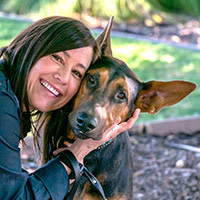
Dr. Shea Cox, DVM, CVPP, CHPV
Dr. Shea Cox is the founder of BluePearl Pet Hospice and is a global leader in animal hospice and palliative care. With a focus on technology, innovation and education, her efforts are changing the end-of-life landscape in veterinary medicine.

Dr. Alycia Washington, DVM, MS
Alycia Washington is a small-animal emergency veterinarian with over 10 years of experience based in North Carolina. She works as a relief veterinarianopens in new tab and provides services to numerous emergency and specialty hospitals. She also works as a veterinary writer with a focus on educating pet parents.
Related articles
![black and white dog looking ill laying on couch]()
Warning Signs Your Dog Needs to Go to the ER — Stat
Trust me, I’m a vet.
![A dog getting checked out at the vet]()
What to Expect At the Emergency Vet
It's every pet parent's nightmare — but knowing what happens when you take your dog to the ER can make the experience a little less stressful.
![shy dog frightened in the arms of the owner. this brown mixed-breed hound puppy has a sweet gaze. the female owner has a wool sweater]()
Why Is My Dog Shaking? Causes and Treatment
A vet explains why the weather isn’t always to blame.
![A woman in an orange cropped jacket walks her white dog toward a vet in a waiting room]()
I Freaked Out at the Emergency Vet So You Don’t Have To
What to expect from and how to make the most of a trip to the ER.
![cat and dog laying on bed together]()
What’s the Deal With Pet Insurance?
It covers your pet so you can get that broken leg fixed—while keeping your wallet happy.
![black scruffy dog wearing cone recovering from spay surgery]()
Everything You Need to Know About Spaying and Neutering Your Dog
A vet’s take on why it’s a smart choice. Snip, snip!
